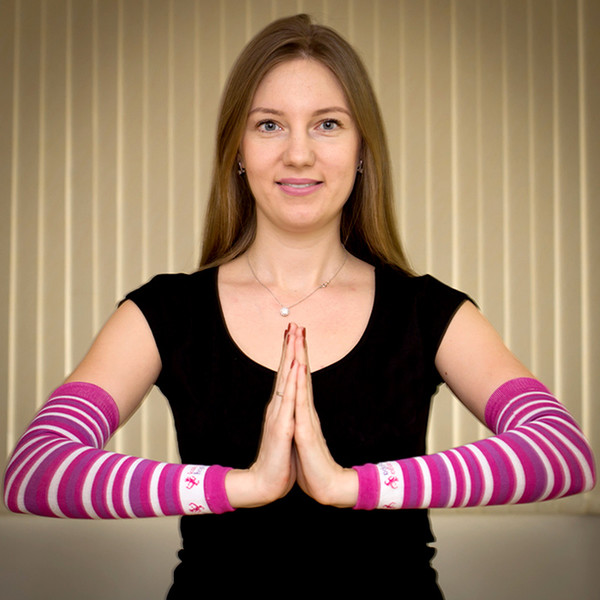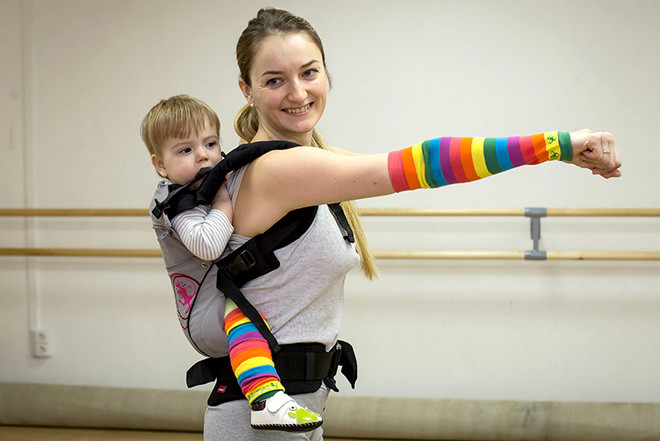After giving birth, every woman wants to come quicklyin shape, but, as a rule, it is not easy to do - an infant limits freedom of action. In addition, young mothers often wonder how to do it in order not to harm their health. Kangatraining is a type of training in which a woman receives a sufficient dose of exercise, and the child is with her. More on the new form of training told kangatrener Olga Vorobyeva. Becoming a coach, Olga solved the problem of lacktime and desire to pay attention to her daughterPhoto: Larisa Kalugina What is kangatraining? - This is an interval, dynamic training, which includes simple choreography, which is easy to follow even for those who do not do aerobics, - says coach Olga Vorobeva. - The beauty is that movement is easy enough to remember. Kangatraining appeared in Austria in 2008. Its founder Nicole Pascher patented the training system after the birth of her third child. Nicole was engaged in fitness at home, but the newborn daughter did not want to lie in a wheelchair, and the mother had to constantly take her in her arms. After consulting with doctors and fitness instructors, a unique training program came into being, in which the mother freely exercised with the child. The kid settles down in an ergo-backpack, or a sling. How convenient it is - judge for yourself! Why after childbirth? - It is important to understand that kang loads are designed for those parts of the body that are primarily affected in pregnant women: the transverse abdominal muscles, pelvic floor muscles, and the spine. The child acts as an additional burden. At the same time, sitting in a backpack on the back of the mother, he feels great, and by the middle of the lesson, as a rule, falls asleep. You can start to train when the newborn is two months old. If the birth was with complications or the woman had a cesarean section - from four months. There are no clear restrictions on when to finish training. A child grows, gains weight, and until it becomes hard for you to do it, it’s safe. How does the training work out? - A training session lasts about an hour, there are several intervals in it. Initially, a 3-5 minutes warm-up: aerobic movements and exercises on the floor. The child at this time on the rug with toys. Next, the baby is placed in a backpack, and the first interval begins: aerobic movements, squats and lunges. The second interval includes dance, the load on the muscles of the hands and exercises at the machine. The third interval is stretching and training the muscles of the pelvic floor. What do you need to start training? - At the first meeting you will need to fill out a questionnaire in which you need to specify in detail information about existing diseases, as well as bring a certificate from a gynecologist confirming that you do not have postpartum complications. Also for training you need a backpack, which on average costs from 4 to 14 thousand, but this does not mean that you have to buy it, because all the accessories — both the backpack and the rug — are handed out. What should I do to become a trainer? - In Russia, kangatrening is still a novelty. I am one of the first to master this type of training. She studied in Austria and brought this system to Russia. In general, anyone can become a kangatrener, just leave a request on the official website of the company.
Becoming a coach, Olga solved the problem of lacktime and desire to pay attention to her daughterPhoto: Larisa Kalugina What is kangatraining? - This is an interval, dynamic training, which includes simple choreography, which is easy to follow even for those who do not do aerobics, - says coach Olga Vorobeva. - The beauty is that movement is easy enough to remember. Kangatraining appeared in Austria in 2008. Its founder Nicole Pascher patented the training system after the birth of her third child. Nicole was engaged in fitness at home, but the newborn daughter did not want to lie in a wheelchair, and the mother had to constantly take her in her arms. After consulting with doctors and fitness instructors, a unique training program came into being, in which the mother freely exercised with the child. The kid settles down in an ergo-backpack, or a sling. How convenient it is - judge for yourself! Why after childbirth? - It is important to understand that kang loads are designed for those parts of the body that are primarily affected in pregnant women: the transverse abdominal muscles, pelvic floor muscles, and the spine. The child acts as an additional burden. At the same time, sitting in a backpack on the back of the mother, he feels great, and by the middle of the lesson, as a rule, falls asleep. You can start to train when the newborn is two months old. If the birth was with complications or the woman had a cesarean section - from four months. There are no clear restrictions on when to finish training. A child grows, gains weight, and until it becomes hard for you to do it, it’s safe. How does the training work out? - A training session lasts about an hour, there are several intervals in it. Initially, a 3-5 minutes warm-up: aerobic movements and exercises on the floor. The child at this time on the rug with toys. Next, the baby is placed in a backpack, and the first interval begins: aerobic movements, squats and lunges. The second interval includes dance, the load on the muscles of the hands and exercises at the machine. The third interval is stretching and training the muscles of the pelvic floor. What do you need to start training? - At the first meeting you will need to fill out a questionnaire in which you need to specify in detail information about existing diseases, as well as bring a certificate from a gynecologist confirming that you do not have postpartum complications. Also for training you need a backpack, which on average costs from 4 to 14 thousand, but this does not mean that you have to buy it, because all the accessories — both the backpack and the rug — are handed out. What should I do to become a trainer? - In Russia, kangatrening is still a novelty. I am one of the first to master this type of training. She studied in Austria and brought this system to Russia. In general, anyone can become a kangatrener, just leave a request on the official website of the company. Irina has been involved in sports all her life and is glad that sheI didn’t have to take a break after giving birthPhoto: Larisa KaluginaIrina, 30:– My daughter is now one year old. I’m very sorry that six months ago there was nothing like this in Rostov-on-Don. You see, when a child is 2-3 months old, it’s inconvenient to study at home, and it’s not interesting either – you want to come to a group. But how? You can’t abandon a child. Kangatraining is a real salvation. My Sofia doesn’t get capricious, she’s very comfortable. By the way, this doesn’t mean that the baby gets used to being in her mother’s arms, rather, on the contrary, she receives so much maternal warmth and care that she requires less attention in everyday life. When a child is more independent, she can play and draw while you study. The trainer explains in detail how to properly place a child in a backpack so as not to hurt him. If you don’t have your own backpack and mat, it’s no big deal, they’ll give them to you on the spot. By the way, the mats here are special, 1.5 centimeters thick and wide, it’s very comfortable to sit on them with your child.
Irina has been involved in sports all her life and is glad that sheI didn’t have to take a break after giving birthPhoto: Larisa KaluginaIrina, 30:– My daughter is now one year old. I’m very sorry that six months ago there was nothing like this in Rostov-on-Don. You see, when a child is 2-3 months old, it’s inconvenient to study at home, and it’s not interesting either – you want to come to a group. But how? You can’t abandon a child. Kangatraining is a real salvation. My Sofia doesn’t get capricious, she’s very comfortable. By the way, this doesn’t mean that the baby gets used to being in her mother’s arms, rather, on the contrary, she receives so much maternal warmth and care that she requires less attention in everyday life. When a child is more independent, she can play and draw while you study. The trainer explains in detail how to properly place a child in a backpack so as not to hurt him. If you don’t have your own backpack and mat, it’s no big deal, they’ll give them to you on the spot. By the way, the mats here are special, 1.5 centimeters thick and wide, it’s very comfortable to sit on them with your child.

Making Money with Desserts: Success Stories
Evgeniya Polischuk (Fedutinova) instagram:@evgeniyafedutinovavk.com/janeshomebaking– It all started with baking for family and friends. Gradually, I started posting photos of my baked goods on Instagram – and orders started coming in. I made my first custom-made cake on October 13, 2014, and a little earlier I started making macaroons and cupcakes. You could say that the business “found me”, I am very […]

Soups are cold recipes with photos
Cold cucumber soup with yogurt and lemonsorbet from the chef of the restaurant La Taverna Alexander Zhurkin Photo: Getty Images Ingredients: Plain yoghurt – 125 g Cucumber – 150 g Lemon/lime sorbet – 50 g Cocktail shrimp – 24 g Fresh ginger juice – 1 g Lime juice – 5 g Fresh orange juice – 5 g Parsley – 1 g Pink pepper – 1 g Watercress – […]

barbeque kebab
Pork tenderloin in glaze Photo:Dmitry Bayrak/dbstudioPreparation time: 20 minutes + marinating time.Calories: 454 kcal per serving.For 4 servings: 4 pork tenderloins (approximately 300 g each), 1 onion, 2 cloves of garlic, 1 tsp. lemon zest, 1 tsp. lemon juice, a pinch of ground cumin, coriander and turmeric, 1 tbsp. vegetable […]

Pierre Duacan: dietary recipes: Ducane diet
Beetroot soup Photo:Season’S, Luxury Hotels RepresentationYou will need:· Boiled beetroot – 60 g· Fresh cucumbers – 20 g· Red radish – 20 g· Green onions – 10 g· Egg – 1 pc.· Drinking mineral water – 200 g· Salt – 1 gPreparation:· Boil the egg and beetroot.· Grate the cucumbers, radish and part of the beetroot. Put everything […]





